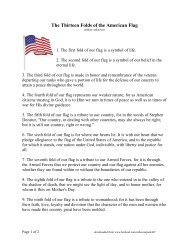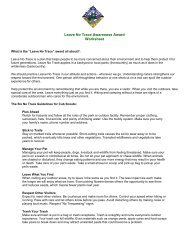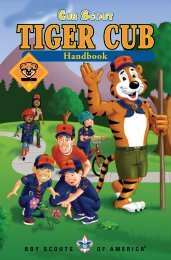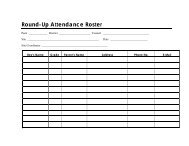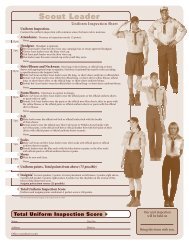For longer <strong>Scouting</strong> events such as summer camp, jamborees,and high-adventure programs, allergy shots required formaintenance doses may be acceptable for persons who havenot had an anaphylactic reaction. Contact the appropriatemedical personnel for the event for confirmation.Ingrown <strong>To</strong>enails, Recent MusculoskeletalInjuries, and Orthopedic SurgeryMany <strong>Scouting</strong> events put a great deal of strain onfeet, ankles, and knees. If the <strong>Scouting</strong> event is physicallydemanding, ingrown toenails should be treated within amonth prior to the event. Scouts and Scouters who havehad orthopedic surgery, including arthroscopic surgery,or significant musculoskeletal injuries, including backproblems, should have a release from the surgeon or treatingphysician to participate in <strong>Scouting</strong> events.Psychiatric/Psychological and EmotionalDifficultiesPsychiatric/psychological and emotional disorders do notnecessarily exclude an individual from <strong>Scouting</strong> events. Parentsand advisers should be aware that most <strong>Scouting</strong> events are notdesigned to assist in overcoming psychological or emotionalproblems and may exacerbate existing conditions. Experiencedemonstrates that these problems frequently are magnified,not lessened, when participants are subjected to the physicaland mental challenges of many <strong>Scouting</strong> activities.Any condition must be well-controlled without the servicesof a mental health practitioner. Under no circumstances shouldmedication be stopped before or during a <strong>Scouting</strong> activity.If the <strong>Scouting</strong> event is an overnight experience, Scouts andScouters are required to bring an appropriate supply ofmedication for the duration of the event, including travel toand from the event.Other Risk FactorsSickle-cell anemia, hemophilia, leukemia, severe blooddyscrasia, and HIV infection provide special challenges toScouts and Scouters. <strong>To</strong> plan for, prepare for, and supportthose having these medical conditions, it is recommendedthat an individual evaluation of each situation be done by theappropriate medical personnel. There may be instances whereproper medical support at the <strong>Scouting</strong> event is impossible.Under such circumstances, participation may be denied.For information on any other health issues, contact yourpersonal health care provider.ImmunizationsThe Boy Scouts of America encourages all members of the<strong>Scouting</strong> community to use available vaccines to fully protectthemselves from infectious diseases that are dangerous forchildren and adults living in the United States. Inadequatelyimmunized participants are subject to identification sothat they may be located in case of a necessity for isolationor quarantine as per local public health official directives.Verification of the following immunizations is recommendedby the <strong>BSA</strong>:• Tetanus (must have been received withinthe last 10 years).• Pertussis• Diptheria• Measles• Mumps• Rubella• Polio• Chicken pox• Hepatitis A• Hepatitis B• InfluenzaMore information about immunizations, as well as theImmunization Exemption Request form, is found under<strong>Scouting</strong> <strong>Safe</strong>ly on www.scouting.org.Protection Considerationfor Blood and Bodily Fluids(Universal Precautions)Treat all blood and bodily fluids as if they were contaminatedwith blood-borne viruses (i.e., HIV, hepatitis). Do notuse bare hands to stop bleeding; always use a protective barrier,and always wash exposed skin areas for at least 15 secondswith soap and water immediately after treating a victim.Consequently, the following personal protective equipment(PPE) is to be included in all first-aid kits and used whenrendering first aid:• Nonlatex gloves to be used when stopping bleeding ordressing wounds.• A mouth barrier device for rendering rescue breathingor CPR.• Plastic goggles or eye protection to prevent a victim’sblood from getting into a rescuer’s eyes in the event ofserious arterial bleeding.The online version of the <strong>Guide</strong> to <strong>Safe</strong> <strong>Scouting</strong> is updated quarterly.Go to http://www.scouting.org/Healthand<strong>Safe</strong>ty/GSS.aspx.23
• Antiseptic for use in sterilizing or cleaning exposed skinareas, particularly if there is no soap or water available.Clean any blood and bodily fluid spills with an appropriatedisinfecting solution, such as 10 parts water to onepart bleach.Occupational <strong>Safe</strong>ty and Health Administration (OSHA)regulations for blood-borne pathogens (29 CFR Section1910.1030) apply to health-care professions employed by localcouncils to staff camp health facilities or to fulfill health officerfunctions at <strong>BSA</strong> camps. In addition, all designated responders,identified in the local council’s medical emergency responseplan, are affected by the regulations. Visit www.osha.gov.Local Council Membership/Participation <strong>Guide</strong>linesRegarding Life-ThreateningCommunicable DiseasesThe <strong>BSA</strong> policy regarding life-threatening communicablediseases is as follows:Local <strong>Scouting</strong> units and their chartered institutionstraditionally determine their own membership, absent anylegal constraints. Accordingly, it is the units and sponsoringinstitutions that determine the feasibility, or desirability, ofallowing youth or adult members who have, or aresuspected of having, a life-threatening communicabledisease, to continue to participate in <strong>Scouting</strong> activities.The chartered organization and/or a local <strong>Scouting</strong> unitmay request local council assistance if needed, absent anylegal restraints. (See Local Council <strong>Guide</strong>lines RegardingCommunicable Disease, No. 19-453, for the steps ofthat process.)Exemptions for Medical Care,Treatment, and ImmunizationsThe following is the Boy Scouts of America’s policyregarding medical requirements:• Medical examinations for camp attendance are requiredof all campers. The immunization requirement may beexempted because of religious, philosophical, or medicalgrounds by signing the Immunization Exemption Requestform (found under forms on <strong>Scouting</strong> <strong>Safe</strong>ly atwww.scouting.org) and receiving a medical evaluationand screening by a licensed health-care practitioner toreduce the possibility of exposing other camp participantsto a communicable disease.• Exemption from all medical treatment may be grantedwith the signing of the Request for Exemption for MedicalCare and Treatment form (found under forms on <strong>Scouting</strong><strong>Safe</strong>ly at www.scouting.org) and receiving a medical evaluationand screening by a licensed health-care practitionerto reduce the possibility of exposing other camp participantsto a communicable disease.PrescriptionsThe taking of prescription medication is the responsibilityof the individual taking the medication and/or that individual’sparent or guardian. A leader, after obtaining all the necessaryinformation, can agree to accept the responsibility of makingsure a youth takes the necessary medication at the appropriatetime, but <strong>BSA</strong> does not mandate or necessarily encourage theleader to do so. Also, if state laws are more limiting, they mustbe followed. <strong>BSA</strong> camp standards may modify this for specificcamp operation.First Aid and CPR TrainingFirst aid is the first help given to someone who has hadan accident or other health emergency. If more attention isneeded, first-aid treatment helps keep an injured or ill personas safe as possible until medical personnel arrive. Wildernessfirst aid (WFA) is the assessment of and treatment given to anill or injured person in a remote environment when a physicianand/or rapid transport are not readily available.First aid and WFA are important to participants in <strong>BSA</strong>programs. Our members’ understanding of first-aid principlesis not only concrete evidence that we are striving to putinto action the <strong>Scouting</strong> ideal of doing a Good Turn daily,it helps Scouts and Scouters be prepared and be safe whenhelping others in need.We strongly recommend that everyone be trained infirst aid and cardiopulmonary resuscitation (CPR) as anendeavor to revive victims of cardiac arrest (no breathing,no pulse). CPR may be taught by instructors currentlytrained by a nationally certified provider such as theAmerican Red Cross, American Heart Association,Emergency Care and <strong>Safe</strong>ty Institute, or American <strong>Safe</strong>tyand Health Institute. Cub Scouts can even be taught thisvaluable skill in a family-type setting.Depending upon the event or activity planned, it may berequired that at least two adults or youth (though three ormore is preferable) in each touring group should have currenttraining in WFA and CPR, know how and when to put thisknowledge to use, and thoroughly understand the limitationsof their knowledge. Further information and advancement infirst aid may include wilderness first responder (WFR) andwilderness emergency medical technician (WEMT).Preliminary skills related to CPR are found in the BoyScout Handbook and the First Aid merit badge pamphlet.24The online version of the <strong>Guide</strong> to <strong>Safe</strong> <strong>Scouting</strong> is updated quarterly.Go to http://www.scouting.org/Healthand<strong>Safe</strong>ty/GSS.aspx.



